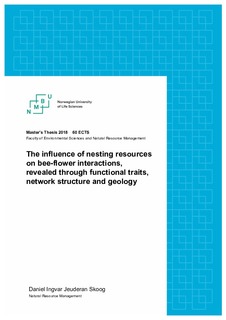| dc.description.abstract | Bees are the major pollinators in most parts of the world, but their diversity have declined as a consequence of environmental changes, during the last century. To counteract this decline, an understanding of the bees and their ecology is essential. Bees are closely connected to the flowers they interact with, and the strength and distribution of these interactions, are to a large extent decided by the functional traits of the interacting species. Bees are also dependent on nesting resources, and this may be a more important driver of bee community assembly, than previously thought. In this study, I assessed the influence of nesting resources, and trait-based ecological filtering on bee-flower interactions, using sandy sediments as a proxy for nest site availability for ground nesting bees.
I sampled bees in roadsides on glaciofluvial (n=8) and marine sediments (n=8), i.e. sandy versus non-sandy sediments. I tested how the probability of floral visitation and number of floral visits, was related to bee and floral functional traits, like sociality, nesting behaviour, tongue-length and flower morphology, as well as to sediment type. I analysed network structure by comparing nestedness and speciality, between sediment types and against null-models.
I found that the probability of floral visitation to actinomorphic flowers, and by short tongued bees was higher on glaciofluvial, than on marine sediments, and that short-tongued bees preferred actinomorphic flowers, while long-tongued preferred zygomorphic flowers. Furthermore, I found the network on glaciofluvial sediments to be less nested and more specialized than the network on marine sediments, and both networks to be less nested and more specialised than what could be expected by chance.
My findings show that bee-flower interactions are filtered on different scales. On a larger spatial scale, by environmental factors connected to nest site availability, and on a smaller scale, within habitats, by trait-matching of tongue length and flower morphology. The patterns of floral visitation, and variation in network structure can be explained by a greater occurrence of specialist interactions of mining bees on glaciofluvial sediment. Mining bees are dependent on sandy soils for excavating their nests, thus revealing the role of geological processes in shaping bee-flower interactions through the allocation of nesting resources. | nb_NO |

